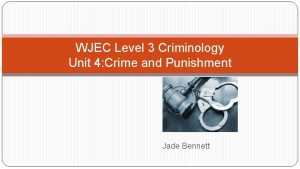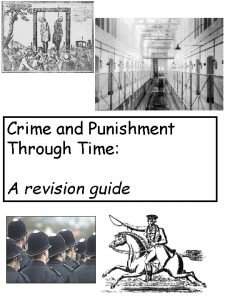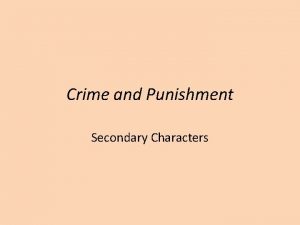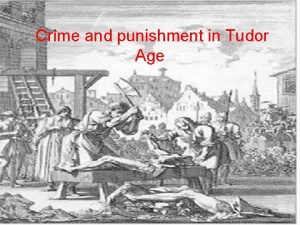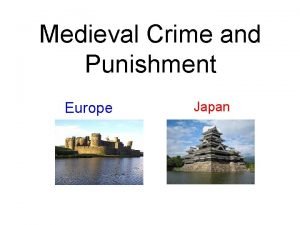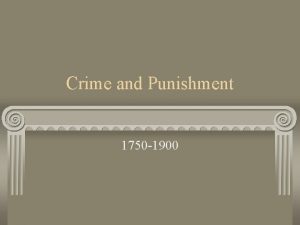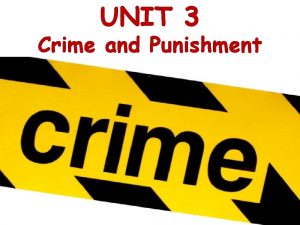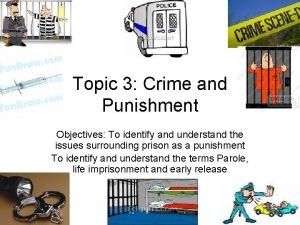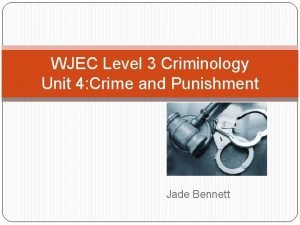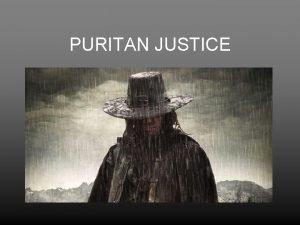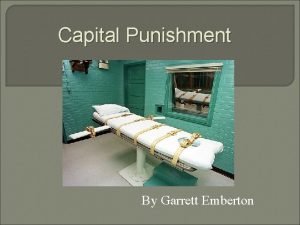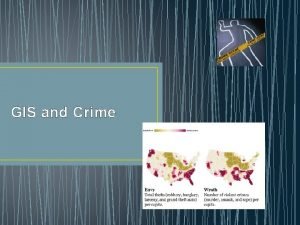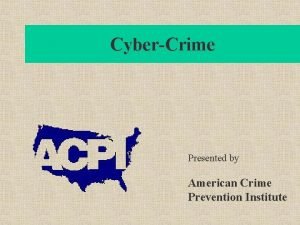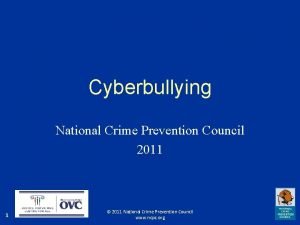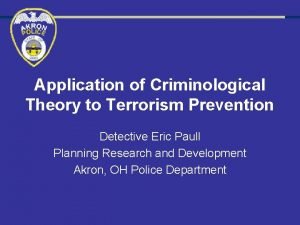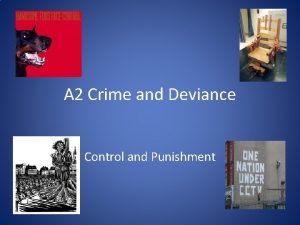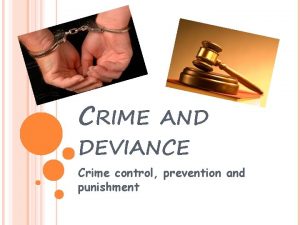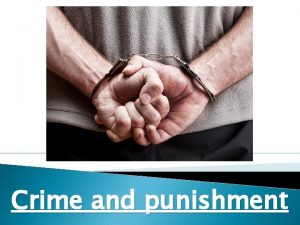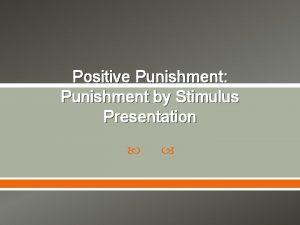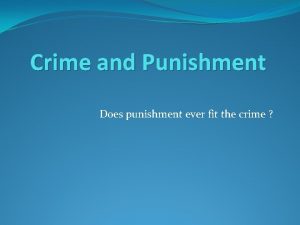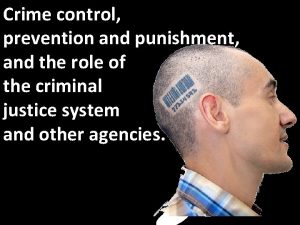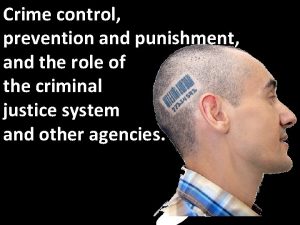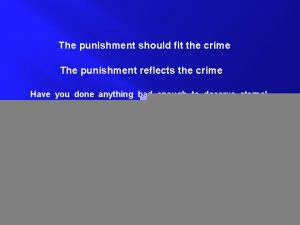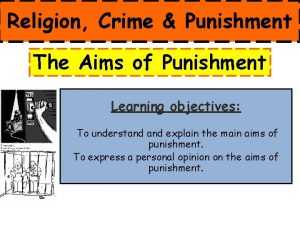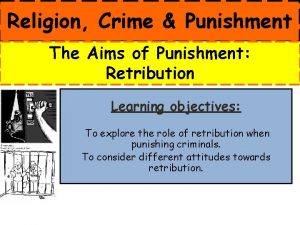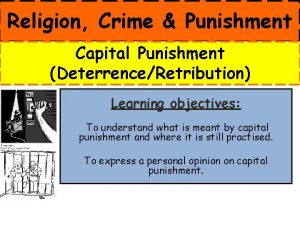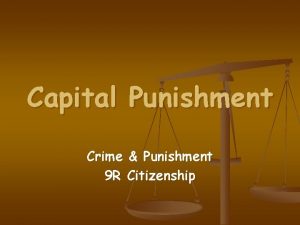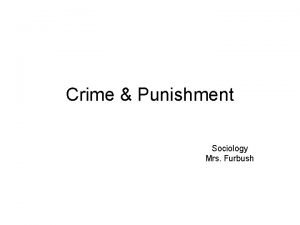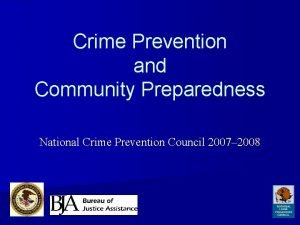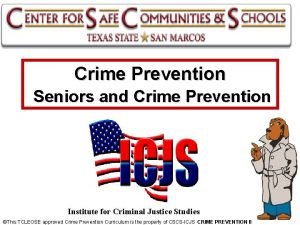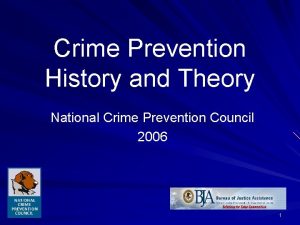Crime control prevention and punishment Lo Critically examine
























- Slides: 24

Crime control, prevention and punishment Lo: Critically examine sociological perspectives on crime prevention and punishment

Social Control • Method of making people stick to the rules and laws of society. These can be formal or informal • Ensures that most of the people most of the time conform • Enforcing conformity means discouraging deviant and criminal behaviour • 2 elements, PREVENTION and PUNISHMENT

Informal Methods of Social Control Prevention • Involves institutions and social groups which are not directly concerned with enforcing social control – E. g. Family, schools, religious organisation • Family teaches norms and values of wider society • Religion reinforces values of society • Significant others (friends, neighbours) people are concerned about others think about them

Formal Methods of Social Control – Prevention • Institutions set up to enforce social control • Institutions which create and enforce the law – E. g. parliament enacts laws, police, judiciary and prison service enforce it

The main agency responsible for enforcement is the police. There are two main positions in understanding the relationship of the police to society. 1. Consensual approach - police having a close relationship with the local area being policed, the police are a reflection of active community helpers they are drawn from the community and reflect characteristics of common values. Individuals are caught due to complaints from the majority. 2. Conflict policing - this model has been suggested by Scraton (1985) who argues that police can be seen as an occupying force imposed upon working class and ethnic- minority communities. Young (1984) describes this as military style policing. Large number of officers patrolling areas in vehicles using advanced technology.

Approaches to Understanding Social Control • Functionalists- see the criminal justice system as operating to look after interests of society as a whole. Without this control = anomie. • Marxists argue that the CJS operates to benefit the ruling class, law and police are both agents of the ruling class. • Postmodernism - Foucault (1977) put the issue of social control at the centre of his writings, society is a battleground of competing interests. The key to gaining power is to have control over knowledge and the methods of achieving this. Those who succeed in having their definition of knowledge accepted gain power and in turn will use this to enforce their view of the world. The CJS play an important part in enforcing these rules.

Control and prevention of crime Right realists Left realists • Emphasize the • Focus on organisation individual of society esp inequality, • Benefitsoutweigh the disadvantage and cost of crime poverty that results • Society needs to from this and the increase cost of enviroment of crime is crime created

Situational crime prevention (SCP) Right Realist measure reducing oppurtunities for crime • Victims should make themselves ‘harder targets’ by investing in more secruity and surveillance • Increase risk of criminal being caught and/or detrring criminality by reducing oppurtunity for crime • Car manufacturers invest in satellite technologies, disabling devices and computerised locking systems has reduced car therft in the UK. • CCTV in shops, secruity guards increase likelihood of shoplifters being caught

Evaluation of SCP • Felson and Clarke SCP displace • Marxists SCP creates new rather then reduce crime. type of social inequality , Criminal move to softer targets poor are disproportionately. E. g Chaiken et al crackdown the main victims of crime on subway robberies in New because m/c can afford York displaced them to the secruity etc streets above • They ignore white collar • Use of surveillance may be a crime , corporate ad state problem because camera crimes which are more operators may subscribe to costly similar stereotypes to police officers and end up focusing in • Marxists and left realist SCP youn males –labelling ignore root cause of crime – poverty and inequality

Enviromental crime prevention (ECP) Right Realist –James Q Wilson • Crime is caused by anti-social behaviour vandalism, graffiti, drugs. If these behaviours are tolerated =‘anything goes’ develops “broken windows thesis” • This happens because little sense of community • Informal and formal social control are weak • Members of community feel powerless • Police target more serious crime and not focus on anti social behaviour • Public housing estates experience most social problems and are likely to found around high-rise tower blocks • These happen because residents do not take responsibility for common entrances , stairwells and lifts as a result anto social elements take over

Wilson proposes • Any sign of enviromental decline such as broken windows or grafitti must be tacked immediatly otherrwise neighberhood deterioration will follow • All public housing should not exceed three floors and all residents should be encouraged to take responsibility of communal space –protect from outsiders • Police should tackle all types of crime and disorder and not just serious crime –zero tolerance –famously adopted in New York to tackle subway graffiti , drug dealing and begging. Between 1993 -1996 crime reduced critics argue this was due to decline in avaiablity of crack cocaine

• No social control • Loose their sense of belonging • Increase in crime • Damaged society Oh my! W hat is this world coming to , I don’t feel safe anymore! This is what I call a perfect neighbourhood • • Well-maintained areas Low crime rates Feel apart of society Less likely to offend Wilson and Kelling (1982)

Social and community crime prevention left realists and other critical criminologists • SCP & ECP treat symptom of crime and not cause • Risk conditions of crimes need to be addressed • such as poverty, unemployment , poor housing etc esp for young and some ethnic minority groups • L. R argue that urban crime is rational response to lack of legitimate oppurtunities and the powerlessness deprived groups feel

• Government through policies should tackle crimes in inner city areas and on sink council estates Educational programmes –improving educational success in inner city areas , reducing exclusions and number of 16 s year olds leaving schools with no qualifications People are paid fair wage so not welfare dependant Reduction in wealth and income inequalities –taxation Invest in poorer urban communities to create jobs

Too soft on crime; evaluation of L. R • Crime is society’s fault rather then looking at individual choice • Fail to explain why most ppl living in poverty do not commit crime • R. R argue L. R make excuses for criminals , tighter control , effective socialisation of children, more severe punishment should be ways to reduce crime

Changes in Social Control • Stan Cohen (1985) has suggested key themes in the changing nature of the formal control in western societies. • Penetration- previously laws were made and haphazardly enforced by whatever authority was around at the time, society now seeks law to be penetrated throughout society, there is more conformity and control right through to the media and schools and even private companies. • Size and Density- people in control or have means of control is much larger then previously. This then leads them to process larger numbers of crime. • Identity and visibility- crime use to be public, now subtle forms of control CCTV, door staff at night clubs. Again drawing on the notion of a surveillance society.

Cont. . Contemporary Social Control �Feeley and Simon- Actuarialism. Feeley and Simon suggest another means to social control in today's age. �The stress of social control has changed form controlling deviants behaviour to controlling potentially deviant people �Therefore agencies work out who is the greatest risk deviant and act against them. �They extend Cohen's point on privatisation and argue that there is large amounts of surveillance which help profit companies.

PUNISHMENT: The role of the prison • Being sent to prison is the most common form of punishment used. • The world prison population is 9 million. • The USA has the highest prison population rate at 700 per 100, 000 • Te UK has the highest rate in Europe at 140 per 100, 000 • There were 18, 000 prisoners in the UK in 1900 • Today there are 87, 000 – each costing the state £ 36, 000 per year.

Punishment � A key component of social control is punishment, it allows us to see how far society goes to maintain social control. � Durkheim- societies can only exist if members share common values and a collective consciousness. A legal system is then put in place to create boundaries. Mechanic societies------retribution (common shared values are broken) Organic (complex) societies- restitutive law (go to prison to make mends for wrong doing. ) � Marxist approaches Rusche and Kircheimer agree that law reflects ruling class and go further stating punishment also reflects their interests. Capitalism has allowed prisons to serve useful proposes, training workers in disciplines of long working hours poor conditions.

Ways in which to reduce crime Deterrance R. R position suggest ‘prisons works’ as priosns deter many potential offenders away from crime by increasing cost of crime Incapacitation R. R prison is important because it removes known criminals from the streets so they cannot offend again. (Note in other societies incapacitation can involving cutting off ppl’s hands, chemical castration and capital punishment ; in Carlifornia ‘three strikes and you are out policy- commiting even a minor third offence can lead to lengthy prison sentence) Rehabilitation Punishment can be used to refor or change offenders to they will not return to their criminal careers. Education and trainignis encouraged so prisoners can earn honest living once out

Do prisons work? • It depends upon which of the key goals you choose to focus on. • In groups, choose one of the three key goals and think of evidence which indicates that prison does or does not work. • Feed back to whole group

Does prison work ? • UK heavily invested on prisons –prison population rose (check what is happening now in the news regarding prisions • Roger Matthews –rather the reducing crimes prisons act as ‘universities of crime’ and ‘expensive way of making bad people worse’. Prisons are ‘warehouses’ in which reasons for offending are rarely addressed and little attempt is made to rehabiliate the offender

• E. Soloman – many people being imprisoned for minor offences in which community punishments more suitable. • High rate if recidivsim –repeat offending suggest prison do not deter. E. g damilola taylors

cont • Foucault- punishment has changed over time. • Offenders were previously seen as having offended against god and others. • Aim of punishment now is to bring a person back into society • Having experts make a person fully internalise the need to conform
 Primary prevention secondary prevention tertiary prevention
Primary prevention secondary prevention tertiary prevention Criminology wjec unit 4
Criminology wjec unit 4 Crime and punishment revision guide
Crime and punishment revision guide Andrei semyonovich lebezyatnikov
Andrei semyonovich lebezyatnikov Tudor crime and punishment
Tudor crime and punishment Wjec criminology unit 4 grade boundaries
Wjec criminology unit 4 grade boundaries Medieval crime and punishment facts
Medieval crime and punishment facts Edexcel gcse history crime and punishment exam questions
Edexcel gcse history crime and punishment exam questions Kahoot crime and punishment
Kahoot crime and punishment Crime and punishment in medieval japan
Crime and punishment in medieval japan Crime and punishment 1750 to 1900
Crime and punishment 1750 to 1900 Unit 4 criminology
Unit 4 criminology Crime and punishment key words
Crime and punishment key words Crime and punishment topic
Crime and punishment topic Wjec criminology unit 4
Wjec criminology unit 4 Tsw crime and punishment
Tsw crime and punishment Puritan crime and punishment
Puritan crime and punishment Thesis statement death penalty
Thesis statement death penalty Plagiarism crime punishment
Plagiarism crime punishment What does target hardening mean
What does target hardening mean Crimegis
Crimegis American crime prevention institute
American crime prevention institute National crime prevention council cyberbullying
National crime prevention council cyberbullying Situational crime prevention definition
Situational crime prevention definition Ron clarke 1992
Ron clarke 1992

